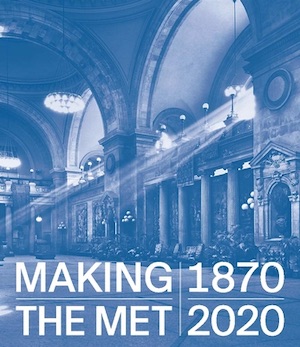By Svetlana Alpers
Having read right through this long, informative book I conclude that its title is to be taken literally. The Met is always in the making, and it is often a messy procedure. The independent chapters on this period or that, or on this collection or that, show that successes in collecting occur haphazardly. And the institutional problems and tensions are structural and remain the same right through. It seems a miracle that a marvelous museum emerged through all of that.
There seem too often to be first-rate curators who are not recognized or properly rewarded, such as Frances Morris (at the Met from 1896 to 1929) who began with musical instruments, ending in textiles and moved out when she could not move up. Here, as in the account of the in and out and in again status of pre-Columbian art at the Met, (the complex relationship between the Met and other New York museums is a subtext) a connection is acknowledged between an interest in collecting textiles and the vital American textile industry. The museum is part of a real world. As for curators, more recently, on the account here, Lowery Stokes Sims in modern art was unfairly overshadowed by Henry Geldzahler until he chose to leave.
The museum’s educational function, stated at its founding, remains, though inconsistently interpreted and erratically pursued. For William Ivins, founder of the department of prints, it meant letting people look, literally hands-on, at works of art. The taped messages that today are carried around on rented earphones and the intrusive iPhones visitors insist on using every minute are a far cry from that. The illustrations in the book remind us that looking is what visitors should be encouraged to do. Museums, Ivins said, should show not tell. It is a profound truth which is not emphasized enough in this book. Indeed, my sense is that museums lack the courage, or is it that they lack the trust in the public to simply say “look” to visitors when they enter and let curious eyes take over.
Coming from European painting, I was surprised by the absence of two superb paintings, great purchases one could put in terms of a museum in the making. Rembrandt’s Aristotle with a Bust of Homer (1653) and Duccio’s tiny Madonna and Child (1290-1300) are not seen in this history of the museum. Is it because they were both purchased from unencumbered funds at the behest of a director—so neither a trustee (the one with the money) nor a curator (the one with knowledge) played a discussable role?
There are many interesting collection nodules to be discovered here. About Egypt, for example, the presence and then passing of so-called partage/shared excavations which meant the host country gave some of what was found to the excavating museum. There was purity about an operation in which no art dealer played a part. Compare that to the illegal trafficking in antiquities so common in recent times. Turning from collection building to curating, there is the fascinating case of a beautiful damaged Egyptian limestone head which in the 1920s the museum restored (to hide the loss), then in the 1970s unrestored (to reveal its actual state), and then in 1993 restored again.
There will always be tension between the status and money of trustees, the expertise and skill of curators, and the need and desires of, or projected onto, the public. There are extraordinary gifts—such as the Havemeyer insistent taste for French modern art. In the troubled history of Modernism at the Met, photography managed to get into the museum by means of a 1928 gift—with no need for approval by the trustees—of 22 of his works by Alfred Stieglitz aided by his friend William Ivins. And then in 1975, the curator Wen Fong negotiated what is described, not quite correctly, as an “offer” of more than 400 works of Japanese art from a dealer which were bought with five years of unrestricted funds voted on directly by curators circumventing the trustees. Building a collection for a museum is a tricky business.
Then there is the catastrophe of World War II for people but also for art. The account here is complex and inevitably confusing. The history—or provenance as it is called—of a number of works in the museum is still unclear. Restitution, confiscation, and publication (of the desired provenance) are the terms in play to which we might add the word booty to call attention to the way art repeatedly changes hands under the gun with museums as one beneficiary. Jean Siméon Chardin’s so-called Soap Bubbles (1733-34) had been seized by the Nazis from the wife of a Jewish collector in Paris who, when the painting was restituted to her, sold it to the Met. A moral tale?
Having reached the full extent of its footprint in Central Park the Met is now expanding in times and cultures. The reasons given for expansion can be bizarre—imagine a writer here commenting, without blinking, that it was the Vietnam War that “heightened awareness of cultures to the east.” Max Hollein, the current director, in his eloquent concluding essay titled “Broadening Perspectives,” understandably emphasizes the art of the Americas and of the present.
But surely in a country obsessed with itself and with progress, objects that are historic and foreign—distant in time and place—need emphasis. Finding things that are strange at first glance is a gift a great museum offers its visitors. On my first post-closure visit, we wandered north into the Asian galleries and came upon an astonishing Chinese calligraphic scroll in a case, stretched out long with subtle brush marks and vacant spaces. Though as writing it is for me unintelligible, as evidence of human making it is confirmation of a common humanity.
Reviewer Svetlana Alpers, an artist, critic, and renowned art historian, is professor emerita of the history of art at the University of California, Berkeley and a visiting scholar in the Department of Art History at New York University.




